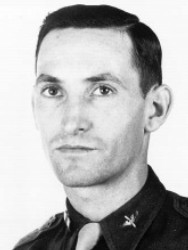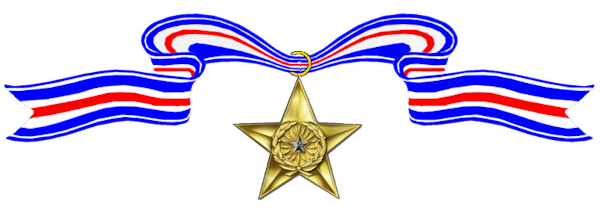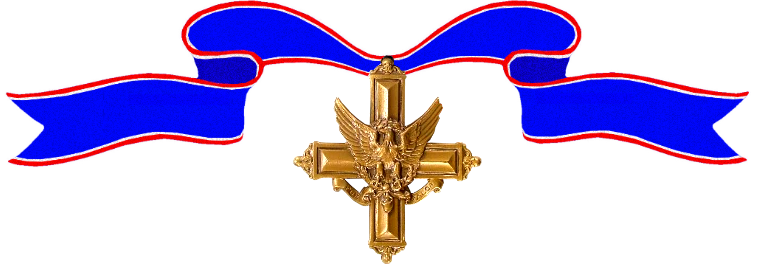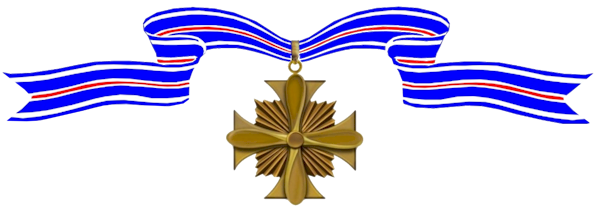George A. Davis flew 266 combat missions in World War II, becoming an Ace with 7 confirmed victories. Flying combat again in Korea, on November 30, 1951, he became the fifth JET ace by downing three TU-2 bombers and a MiG-15 in a single sortie. Major Davis achieved Double-Ace status with 14 confirmed victories in Korea before he was Killed in Action on February 10, 1952, in an action that earned him the Medal of Honor.

–
Cemetery:
Awards Received
-

Silver Star
-

Silver Star
-

Distinguished Service Cross
-

Silver Star
-

Medal of Honor
-
Silver Star
Service:
United States Air ForceRank:
MajorBatallion:
334th Fighter-Interceptor SquadronRegiment:
4th Fighter-Interceptor GroupDivision:
5th Air ForceAction Date:
November 30, 1951
General Headquarters Far East Air Forces, General Orders No. 3 (January 4, 1952), Amended by GO No. 89 (February 19, 1952)The President of the United States of America, authorized by Act of Congress, July 9, 1918, takes pride in presenting a Bronze Oak Leaf Cluster in lieu of a Second Award of the Silver Star (Posthumously) to Major George Andrew Davis, Jr. (AFSN: 671514/13035A), United States Air Force, for gallantry in action against an enemy on 30 November 1951 as Pilot of an F-86 Sabrejet Fighter-Bomber of the 334th Fighter-Interceptor Squadron, 4th Fighter-Interceptor Group, FIFTH Air Force, while leading a formation of eight F-86 aircraft on a combat aerial patrol in the Sinuiju-Yalu River area in Korea. Shortly after arriving in the target area, Major Davis sighted a formation of approximately 12 enemy TU-2 type bomber aircraft escorted by large numbers of enemy MiG-15 and LA-9 type fighter aircraft. In spite of the overwhelming odds against him, Major Davis immediately maneuvered his Squadron into position to press home his attack. With outstanding airmanship, he led his formation on the initial pass on the bombers, scoring numerous strikes on the first box of three. While maneuvering for an immediate second attack on the bombers, his wingman became separated and was unable to rejoin him. Major Davis, disregarding his own safety, returned to the attack, although alone and without knowledge of friendly forces in the area. Despite the intense fire from the enemy bomber formation, he pressed home four more attacks with such effectiveness that he personally destroyed three enemy bombers. Major Davis was forced to withdraw after expending nearly all his ammunition and running critically low on fuel. While proceeding southward toward friendly territory, Major Davis heard a distress call from the element leader of his Flight. Although fully aware that he had less than the minimum amount of fuel remaining to insure safe return to a friendly base, Major Davis altered course 180 degrees and proceeded at full power to the location of the pilot. When he arrived he found his pilot’s aircraft disabled by enemy fire and in imminent danger of being destroyed by MiG-15s, which were forming for a final attack on the damaged F-86. Major Davis immediately brought accurate fire on the enemy, destroyed one MiG-15, dispersed the remaining, forcing them to break off their attack. He escorted the disabled aircraft out of the danger zone, into friendly territory. When he finally landed, he had less than five gallons of fuel remaining. Through his skill, Major Davis saved the life of a fellow pilot and caused the destruction of four enemy aircraft, bringing his total score to six destroyed and two probably destroyed. Major Davis’ outstanding airmanship and gallantry reflected great credit upon himself, the FAR EAST Air Forces, and the United States Air Force.
-
Silver Star
Service:
United States Army Air ForcesRank:
Captain (Air Corps)Batallion:
342d Fighter SquadronRegiment:
348th Fighter GroupDivision:
5th Air ForceAction Date:
December 24, 1944
Headquarters, Far East Air Forces, General Orders No. 356 (March 9, 1945)The President of the United States of America, authorized by Act of Congress, July 9, 1918, takes pleasure in presenting the Silver Star to Captain (Air Corps) George Andrew Davis, Jr. (ASN: 0-671514/13035A), United States Army Air Forces, for gallantry in action while serving as Pilot of a P-47 Aircraft of the 342d Fighter Squadron, 348th Fighter Group, FIFTH Air Force, in action over Clark Field, Manila, Philippine Islands, on 24 December 1944. Captain Davis was leading a flight of three P-47 type aircraft in a formation escorting B-24 bombers on a mission when he saw two enemy fighters making a pass at the bombers from approximately 1,000 feet above. He immediately turned in pursuit of one, chasing it to within firing distance, where his wingman shot it down, causing the pilot to bail out. He then took his flight back to maintain cover for the bombers. Soon afterwards he observed a formation of eight to ten enemy planes attacking our P-47s. Captain Davis thereupon went after one of them and fired three bursts which resulted in the airplane’s breaking into flames and crashing into the mountain. Returning again to his position he saw another enemy fighter heading for the bomber formation. Acting quickly, he climbed after it, firing from 200 yards range. Pieces flew off the Japanese plane, and it burst into flames and crashed. The superb protection afforded the bombers by Captain Davis enabled them to carry out their runs with telling effect. Captain Davis’ gallantry and leadership are in keeping with the highest tradition of the United States Army Air Forces.
-
Distinguished Service Cross
Service:
United States Air ForceRank:
MajorBatallion:
334th Fighter-Interceptor SquadronRegiment:
4th Fighter-Interceptor GroupDivision:
5th Air ForceAction Date:
November 27, 1951
Headquarters, Far East Command: General Orders No. 92 (April 4, 1952).The President of the United States of America, under the provisions of the Act of Congress approved July 9, 1918, takes pride in presenting the Distinguished Service Cross (Air Force) (Posthumously) to Major George Andrew Davis, Jr. (AFSN: 0-671514/13035A), United States Air Force, for extraordinary heroism in connection with military operations against an armed enemy of the United Nations while serving as Pilot of an F-86 Sabrejet Fighter and as Squadron Commander of the 334th Fighter-Interceptor Squadron, 4th Fighter-Interceptor Group, FIFTH Air Force, on 27 November 1951, during an engagement with enemy aircraft near Sinanju, Korea. While leading a group formation of thirty-two F-86 aircraft on a counter air mission, Major Davis observed six MiG-15 aircraft headed southward above the group. With exemplary leadership and superior airmanship, he maneuvered his forces into position for attack. Leading with great tactical skill and courage, Major Davis closed to 800 feet on a MiG-15 over Namsi. He fired on the enemy aircraft, which immediately began burning. A few seconds later, the enemy pilot bailed out of his aircraft. Continuing the attack on the enemy forces, Major Davis fired on the wingman of the enemy flight, which resulted in numerous strikes on the wing roots and the fuselage. As Major Davis broke off his relentless attack on this MiG-15, another MiG-15 came down on him. He immediately brought his aircraft into firing position upon the enemy and after a sustained barrage of fire, the enemy pilot bailed out. Although low on fuel, he rejoined his group and reorganized his forces to engage the approximate 80 enemy aircraft making the attack. Against overwhelming odds, Major Davis’ group destroyed two other MiG-15 aircraft, probably destroyed one and damaged one other. Major Davis’ aggressive leadership, his flying skill and devotion to duty contributed invaluable to the United Nations’ cause and reflect great credit on himself, the Far East Air forces and the United States Air Force.
-
Silver Star
Service:
United States Air ForceRank:
MajorBatallion:
334th Fighter-Interceptor SquadronRegiment:
4th Fighter-Interceptor GroupDivision:
5th Air ForceAction Date:
December 13, 1951
General Headquarters Far East Air Forces, General Orders No. 135 (March 19, 1952)The President of the United States of America, authorized by Act of Congress, July 9, 1918, takes pride in presenting a Second Bronze Oak Leaf Cluster in lieu of a Third Award of the Silver Star (Posthumously) to Major George Andrew Davis, Jr. (ASN: 0-671514/13035A), United States Air Force, for gallantry in action against an enemy as Pilot of an F-86 Sabrejet Fighter-Bomber and as Squadron Commander of the 334th Fighter-Interceptor Squadron, 4th Fighter-Interceptor Group, FIFTH Air Force, in the Sinanju-Anju area of North Korea on 13 December 1951. On that date, Major Davis was leader of a squadron of eight F-86 aircraft on a counter-air mission, when he observed a flight of ten MiG-15 enemy aircraft. He immediately initiated a coordinated attack and led his forces into the engagement. The vicious assault was relentlessly pressed and resulted in five MiG-15s destroyed and a sixth probably destroyed by the members of Major Davis’ squadron. Major Davis was personally responsible for the destruction of two MiG-15 aircraft. None of his squadron sustained damage in achieving this victory over the enemy. The personal courage and outstanding qualities of leadership exhibited by major Davis contributed immeasurably to the greatest defeat inflicted upon the enemy in a single jet-to-jet engagement. As a result of his gallantry, leadership and brilliant tactical skill, Major Davis reflected great credit upon himself, the FAR EAST Air Forces, and the United States Air Force.
-
Medal of Honor
Service:
United States Air ForceRank:
MajorBatallion:
334th Fighter-Interceptor SquadronRegiment:
4th Fighter-Interceptor GroupDivision:
5th Air ForceAction Date:
February 10, 1952
Department of the Air Force, General Orders No. 20 (April 30, 1954)The President of the United States of America, in the name of Congress, takes pride in presenting the Medal of Honor (Posthumously) to Major George Andrew Davis, Jr. (ASN: 0-671514/13035A), United States Air Force, for conspicuous gallantry and intrepidity at the risk of his life above and beyond the call of duty while serving as Pilot of an F-86 Sabrejet Fighter of the 334th Fighter-Interceptor Squadron, 4th Fighter-Interceptor Group, FIFTH Air Force in action against enemy forces near Sinuiju-Yalu River, Korea, on 10 February 1952. While leading a flight of four F-86 Saberjets on a combat aerial patrol mission near the Manchurian border, Major Davis’ element leader ran out of oxygen and was forced to retire from the flight with his wingman accompanying him. Major Davis and the remaining F-86’s continued the mission and sighted a formation of approximately twelve enemy MiG-15 aircraft speeding southward toward an area where friendly fighter-bombers were conducting low level operations against the Communist lines of communications. With selfless disregard for the numerical superiority of the enemy, Major Davis positioned his two aircraft, then dove at the MiG formation. While speeding through the formation from the rear he singled out a MiG-15 and destroyed it with a concentrated burst of fire. Although he was now under continuous fire from the enemy fighters to his rear, Major Davis sustained his attack. He fired at another MiG-15 which, bursting into smoke and flames, went into a vertical dive. Rather than maintain his superior speed and evade the enemy fire being concentrated on him, he elected to reduce his speed and sought out still a third MiG-15. During this latest attack his aircraft sustained a direct hit, went out of control, then crashed into a mountain 30 miles south of the Yalu River. Major Davis’ bold attack completely disrupted the enemy formation, permitting the friendly fighter-bombers to successfully complete their interdiction mission. Major Davis, by his indomitable fighting spirit, heroic aggressiveness, and superb courage in engaging the enemy against formidable odds exemplified valor at its highest.


